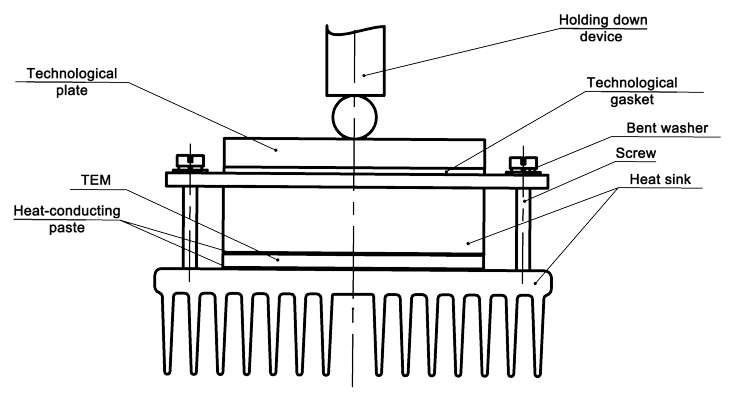Installation of thermoelectric modules
Since thermoelectric modules (TEM) consist of quite brittle components, it is therefore necessary to pay special attention to certain details during its operation and installation.
There are some restrictions for the operation of the module:
- Do not allow moisture and foreign objects to enter inside the thermoelectric module (between semiconductor elements).
- Do not bend the lead wires at a distance of less than 5 mm from their soldering points.
- It is not allowed to operate the module at currents exceeding Imax.
- Do not operate the module at temperatures exceeding the maximum permissible operating temperature Tmax.
- It is forbidden to operate module with cracks in ceramic plates formed as a result of a fall or during installation.
- It is forbidden to solder (re-solder) lead wires from (to) ceramic plates of module.
- It is not recommended for the user to seal module by himself.
TEM connection to power supply
When connecting the module to the power source by soldering, lead wires shall be soldered to the power supply contacts at a distance of not less than 15 mm from the module.
When connecting the module to a direct current source, the polarity must be observed: the product lead wires must be connected to the terminals of the source of the corresponding polarity.
The DC pulsation should not exceed 5%, as exceeding the ripple level of more than 5% will cause a decrease in the efficiency of module cooling.
Mounting of TEM on the heat exchanger (heat sink).
Since the module is a heat pump, it is necessary to ensure efficient heat dissipation from its hot side. It is necessary to take into account that not only "pumped" heat, but also consumed power will have to be dissipated from the module. Various components can be used for heat dissipation: air or liquid heat exchangers (heat sinks), heat pipes, etc.
The surface of the heat exchanger to which the module is attached must have a flatness of not more than 0.025 mm.
Before installation, the surface of the module should be degreased with a calico cloth moistened with acetone or "Kalosha" gasoline. Than a layer of heat-conducting paste with thickness of (0.08-0.15 mm) should be applied to the heat exchanger surface.
Install the module "hot" side on the heat exchangers with the paste. The TEM is to be reseated to the heat exchangers surface, pressing the module against the heat exchangers by hand until the friction increases. Remove the residue of the separated paste with a dry clean cloth.
Notes:
1. Do not allow heat conductive paste to enter inside the module.
2. The paste should not shunt the hot and cold faces of the module.
Install the heat sink (cooling object) on the cold side of the module in the same way: apply a layer of heat-conducting paste to the cooling surface and reseat it.
A pressure pad (holding down device) shall be applied to the mechanical center of module to provide uniform pressure over the whole surface of cooling object. It is recommended to use elastic service padding and service plate (technological gasket and plate) between pressure pad and heat sink (module) with flatness and parallel difference not less than 0,05 mm.
A pressure pad (holding down device) is better to be made with like-a-ball form to provide central pressure for uniform force distribution on the whole surface of the module.
See picture for designations

Figure – TEM Installation on the heat sinks
Provide the pressure (connection force of the heat sink and the cooling object with TEM), which must be 6-12 kg/сm2 for standard single-stage modules. The pressure must be 2-6 kg/сm2 for microcoolers, and 4-10 kg/сm2 for multi-stages thermoelectric modules.
Tighten the screws until the Grover washers are fully straightened. The torque of the screws must be such that the loads created by the screws on the TEM are no more than 10% of the load created by the pressure pad.
The installation of the module should be carried out in such a way as not to destroy the structural elements of the module.
Storage and transportation.
Modules should be stored in heated rooms at a temperature of plus 5 °C to plus 40 °C and a relative humidity of not more than 80%. Modules during storage should be protected from direct moisture and mechanical damage.
Modules packed in the manufacturer packing are allowed to be transported by all means of transport (including in heated airtight aircraft compartments) without limiting the distance at a temperature from minus 50 °С to plus 60 °С and atmospheric pressure from 70 to 108 kPa.
When transporting the modules, protection from dust and atmospheric fallouts should be provided.

